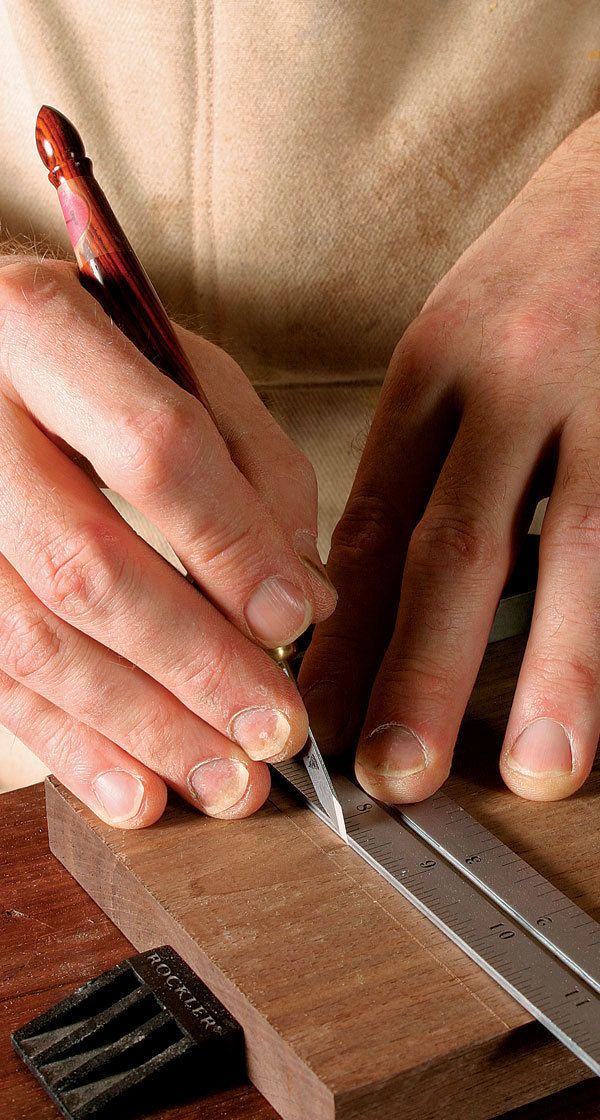Tool Test: Marking Knives
These must do more than follow a straightedge
Synopsis: Marking knives are simple tools, but crucial to fine craftsmanship. A good one will cut wood fibers cleanly, leaving a crisp line that’s deep enough to anchor a chisel. It must fit into tight spaces and be easy to hold using a pencil-style grip. Users of marking knives, such as Steve Latta, often choose a knife based on the type of work they do. With this in mind, Latta sampled more than a dozen knives, using them to mark out dovetails, trace a hinge, mark for a banding, and trace the boundaries of an inlay mortise. The knives ranged widely in price, up to about $45. Yet his favorite costs less than $3.
The marking knife seems like such a simple tool that it would be easy to dismiss it as little more than a blade and a handle. But we all know better: Marking out with a knife instead of a pencil means that you care about the details. So it makes sense to focus on the details when choosing the knife. A good marking knife will do a number of things well. It will cut wood fibers cleanly, leaving a narrow, crisply defined line, easily visible and deep enough to anchor a chisel. The blade will fit into tight spaces and the tool will be easy to hold in a pencil-style grip.
That said, individual needs and preferences do play a role in choosing a knife. I do a lot of inlay, for example. For me, a skew point with two bevels and a slightly flexible blade is key for accurately marking out bellflowers and bandings. Also, because I move around a lot between student benches in a large shop, I favor a small, lightweight knife that I can carry in my apron. You might be surprised to learn that I’ve used a simple X-Acto for many years.
My friend Bess, on the other hand, builds tall-case clocks with huge dovetails in their hoods. She finds a large marking knife with a long, thick blade best suited to the task. Fellow contributing editor Chris Becksvoort recommends having a variety of marking knives handy but says he personally favors a straight chip-carving knife. The bottom line: One size or style does not fit all.
I sought to keep that in mind and to set aside my own preferences as I sampled more than a dozen knives representing the most common designs among the many knives on the market. Some are specifically for layout. Others are carving or craft knives popular with woodworkers as layout tools. I was eager to see whether any of them would make me want to give up my trusty X-Acto.
A good knife handles a variety of tasks
I put each knife through five tests, each a real-world woodworking task:
Scoring a line—With the blade riding against a combination square, I struck a line across 5-in.-wide pieces of walnut and curly maple. I was looking for quality of line in both softer and harder material.
Dovetailing—I marked out a pin board for a set of narrowly spaced tails across a 6-in.-wide piece of 3⁄4-in. stock. The narrow spacing tested each knife’s ability to strike a line in confined quarters.
From Fine Woodworking #198
For the full article, download the PDF below:
Fine Woodworking Recommended Products

Starrett 4" Double Square

Lie-Nielsen No. 102 Low Angle Block Plane

Veritas Wheel Marking Gauge























Comments
At the end of the day my preference is the X-ACTO. I have other types but one of the things I like best about X-ACTO aside from the price is I don’t have to sharpen it. I already have enough things in my shop to sharpen.
Log in or create an account to post a comment.
Sign up Log in